Sydney’s Most Interesting Stays Aren’t the Biggest Ones
Big hotels dominate Sydney’s skyline. Their glass walls catch the morning light, their lobbies echo with suitcase wheels, and their size promises everything in one place. Yet, for all that space, something often feels missing. Guests get efficiency but lose intimacy. They’re seen but rarely known.
Down in Surry Hills, a different idea of hospitality unfolds. Here, smaller properties turn their limits into character. They don’t compete with skyscrapers; they compete with sameness. Each stay feels distinct, shaped more by people and place than by policy. Adge Hotel Sydney fits into that shift a reminder that size doesn’t define experience.
What sets boutique hotels apart is their ability to adapt. Without hundreds of identical rooms, they can design with personality. A colour choice can reflect the neighbourhood. Artwork can reference local stories. Even the staff learn names rather than booking numbers. The experience becomes personal, not programmed. Small gestures matter fresh bread from the café next door, directions to a gallery that fits your taste. Guests leave feeling seen, not processed.
Travellers notice. Many arrive expecting less and leave realising they got more. In a large chain, amenities feel standardised predictable breakfast spreads, uniform lighting, generic décor. In contrast, smaller hotels create emotional space. They let guests slow down, observe, and take part in the neighbourhood rather than simply passing through it.
Surry Hills helps that process. Its streets run close together, and its culture runs deep. Cafés double as creative hubs, and old warehouses hide new ideas. A hotel built here doesn’t just host tourists; it joins a community. That connection changes how guests experience Sydney. They see less of the postcard version and more of the human one.
The rooms at Adge Hotel Sydney mirror that approach. They’re designed with clarity rather than clutter, offering comfort without excess. Every piece of furniture feels deliberate. The focus isn’t on impressing guests with scale but on making them feel at ease. There’s space to think, to read, to plan the next walk outside. The luxury is in how naturally it all fits together.
Of course, some travellers still prefer the big-hotel model. It’s easy to understand the draw: predictable service, extensive facilities, loyalty points. Yet predictability can sometimes flatten an experience. When everything looks the same from Melbourne to London, the sense of discovery disappears. Boutique hotels resist that uniformity by celebrating location instead of hiding it.

Image Source: Pixabay
Surry Hills is an example of why that matters. The neighbourhood hums with local energy, from vintage shops to rooftop bars. Every street corner feels slightly improvised, like the city is still figuring itself out. Guests staying nearby feel that energy bleed into their routine. They might talk to the same barista each morning or discover a favourite dinner spot by accident. Those small encounters make a stay feel lived, not staged.
Adge Hotel Sydney builds on that truth. It shows that travel doesn’t have to be measured by scale or service lists. It can be measured by connection between guests, hosts, and the city itself. Visitors leave with memories that fit no brochure but feel completely their own.
In a world that prizes more of everything more floors, more restaurants, more views the real luxury might be subtraction. Cutting away the excess reveals something better: space for attention. That’s what smaller hotels understand and what many travellers now seek. Not spectacle, but sincerity. Not size, but soul.
And maybe that’s why, across Sydney, the most interesting stays keep getting smaller. They don’t need to tower over the city to stand out. They just need to belong to it.
Comments